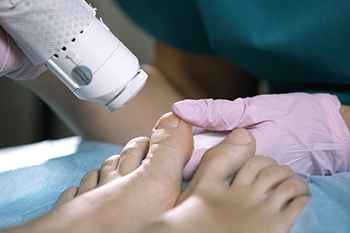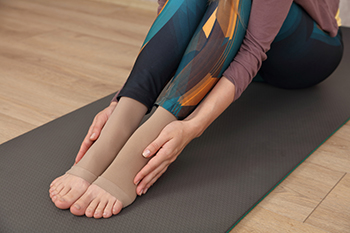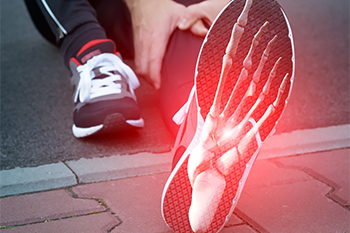Items filtered by date: March 2022
Preventing Falls for Older Adults
 Among elderly adults, falls are one of the leading causes of injury and disability. Although it is true that as people age, they are more likely to experience a fall, falling is not an inevitable part of aging. There are many steps that older adults and their families can take to reduce the risk of falling. Since most falls happen in the home, it is helpful to focus on reducing tripping and falling hazards inside the house. Removing clutter from the living area, ensure that there is adequate lighting, putting non-slip mats in wet or slippery areas, and installing grab bars in the shower can all lower the risk of a fall. Taking care of your health is also vital for falls prevention. Regularly visiting a chiropodist, who can treat any existing foot problems that may contribute to the risk of falling and help you maintain your mobility, can be very beneficial.
Among elderly adults, falls are one of the leading causes of injury and disability. Although it is true that as people age, they are more likely to experience a fall, falling is not an inevitable part of aging. There are many steps that older adults and their families can take to reduce the risk of falling. Since most falls happen in the home, it is helpful to focus on reducing tripping and falling hazards inside the house. Removing clutter from the living area, ensure that there is adequate lighting, putting non-slip mats in wet or slippery areas, and installing grab bars in the shower can all lower the risk of a fall. Taking care of your health is also vital for falls prevention. Regularly visiting a chiropodist, who can treat any existing foot problems that may contribute to the risk of falling and help you maintain your mobility, can be very beneficial.
Falls are a common but preventable problem for older adults. If you would like to learn more about preventing falls, please consult with Chiropodist Stephanie Poupore from North Bay Foot & Ankle. Our clinician can help you maintain the health of your lower limbs and your mobility.
Did you know that most falls occur in the home? Fortunately, there are many simple changes that you can make to the living environment to reduce the risk of falling.
In the Bathroom:
-
Install grab bars near toilets, bathtubs, and showers
-
Put non-skid mats on all surfaces that may get wet
In the Bedroom:
-
Keep a light near the bed so that you can easily turn it on if you have to get up at night
-
Keep the path from your bedroom to the bathroom clutter-free and well-lit
-
Consider installing a bed rail for added support
In the Kitchen:
-
Use non-skid mats
-
Wipe up any spills immediately
-
Move commonly used items to areas that are easily within your reach
In the Hallways:
-
Place handrails on both sides of the stairs
-
Install good lighting in the hallways and around the entire home
-
Keep hallways free of clutter
-
Don’t use throw rugs or small area rugs
In Other Living Areas:
-
Keep loose cables, cords, and wires near the wall and away from walking surfaces
-
Make sure that all carpets and rugs are secure firmly to the floor
-
Arrange your furniture so that it is not in your way when you walk
-
Use chairs and couches that you can easily get up from
If you have any questions, please feel free to contact our office located in . We offer the newest diagnostic and treatment technologies for all your foot care needs.
Read more about Falls PreventionIs My Toe Broken?
 A toe fracture is a serious injury. It’s typically caused by stubbing the toe or having something fall onto the toe. Immediately following the injury, your toe will throb. You may also hear the cracking sound of a toe bone breaking. A broken toe often swells, and the skin around the injury usually becomes bruised. All of this leads to pain that can make it difficult or impossible to bear weight on the toe. Severe breaks can also cause the toe to dislocate and bend at an unnatural angle. In an open fracture, the broken bone may even poke through the skin. If you have injured your toe, it’s strongly suggested that you seek the care of a chiropodist as soon as possible.
A toe fracture is a serious injury. It’s typically caused by stubbing the toe or having something fall onto the toe. Immediately following the injury, your toe will throb. You may also hear the cracking sound of a toe bone breaking. A broken toe often swells, and the skin around the injury usually becomes bruised. All of this leads to pain that can make it difficult or impossible to bear weight on the toe. Severe breaks can also cause the toe to dislocate and bend at an unnatural angle. In an open fracture, the broken bone may even poke through the skin. If you have injured your toe, it’s strongly suggested that you seek the care of a chiropodist as soon as possible.
A broken toe typically occurs following either a sudden, traumatic injury, like dropping a heavy piece of furniture on the toe. The impact causes the bone to fracture and produces a variety of painful symptoms. If you suspect that you’ve broken your toe, please consult with Chiropodist Stephanie Poupore from North Bay Foot & Ankle. Our clinician can help you maintain the health of your lower limbs and your mobility.
Symptoms
-
Throbbing pain
-
Swelling
-
Bruising
-
Cracking sound at the time of injury
-
Difficulty bearing weight on the toe
-
Difficulty walking
-
Toe resting at an unnatural angle
Diagnosis
Your chiropodist can diagnose a broken toe through physical examination and imaging studies, such as X-rays.
Treatment
The main goals of treatment are to ensure that the bone heals properly, as a toe fracture that doesn’t heal properly can lead to osteoarthritis. You will typically need to rest the affected toe. You may be prescribed a splint to immobilize the toe while it heals. Icing the affected toe and taking over-the-counter medications can help reduce pain. In cases of severe fractures, surgery may be necessary to reset the broken bones and make sure that they heal correctly.
If you have any questions, please feel free to contact our office located in . We offer the newest diagnostic and treatment technologies for all your foot care needs.
Read more about Broken ToeGout Pain Can Be Managed
Laser Treatment for Toenail Fungus
 A fungal infection of the toenails, also known as onychomycosis, can be difficult to treat. Topical medications are often not very effective because they do not penetrate the nail, while oral antifungal medications can have potentially harmful side effects. Another popular treatment option is laser therapy. This treatment uses a concentrated beam of light aimed at the infected toenails to kill the fungi underneath. Laser treatment has been found to be safe and effective, with minimal side effects. Furthermore, laser treatment can be safely combined with other treatment methods to yield even better results. If you have toenail fungus, don’t hesitate to reach out to a chiropodist who can discuss available treatment options with you.
A fungal infection of the toenails, also known as onychomycosis, can be difficult to treat. Topical medications are often not very effective because they do not penetrate the nail, while oral antifungal medications can have potentially harmful side effects. Another popular treatment option is laser therapy. This treatment uses a concentrated beam of light aimed at the infected toenails to kill the fungi underneath. Laser treatment has been found to be safe and effective, with minimal side effects. Furthermore, laser treatment can be safely combined with other treatment methods to yield even better results. If you have toenail fungus, don’t hesitate to reach out to a chiropodist who can discuss available treatment options with you.
Onychomycosis, also known as a fungal toenail infection, is not only a cosmetic concern but can also impact the health of your feet and your quality of life. If you have toenail fungus, please consult with Chiropodist Stephanie Poupore from North Bay Foot & Ankle. Our clinician can help you maintain the health of your lower limbs and your mobility.
Toenail fungus causes changes in the appearance of the nails. As the fungus spreads, the infected toenails can become thickened, brittle, crumbly, and discolored. Over time, the infection can worsen, making the toenails misshapen. They may begin to separate from the nailbed and can emit a foul odor. In addition to being unsightly, this condition can also be painful. The raised toenails may rub uncomfortably against your shoes, hurting you as you walk. People with diabetes or compromised immune systems can suffer serious consequences from a fungal infection, and the fungus can spread to the skin of the feet and from person to person. Toenail fungus can also affect your mental health, making you feel that you need to hide your toenails in closed-toe shoes at all times.
Treatments for fungal toenail infections typically include topical solutions that are applied directly to the nail, oral antifungal medications, and laser treatment. Both topical and oral antifungals can take a long time to work. Topical medications tend to be less effective, as they can’t penetrate the nail, while oral antifungals can cause unwanted side effects. Laser treatment tends to work faster and is safer and sometimes more effective than the alternatives. It can also be used safely in conjunction with other treatments. If you have toenail fungus and would like to find out if laser treatment is right for you, please feel free to contact our office located in . We offer the newest diagnostic and treatment technologies for all your foot care needs.
Read more about Laser Treatment for Fungal NailsSymptoms of Poor Circulation in the Feet
 Poor circulation refers to impaired blood flow. This can happen in any part of the body but is particularly common in the feet. If you have poor foot circulation, you may experience a variety of symptoms. These can include cold feet, numbness, tingling or a pins and needles sensation, swelling, skin discoloration, pain or aching, a feeling of heaviness in the feet, and increased fatigue. Poor circulation can have many causes. It becomes more common as we age but can also be brought about by a sedentary lifestyle or obesity. Poor foot circulation is also associated with certain medical conditions, such as diabetes, deep vein thrombosis, atherosclerosis, peripheral artery disease, and venous insufficiency. If you have poor circulation in your feet, a chiropodist can help you manage this condition.
Poor circulation refers to impaired blood flow. This can happen in any part of the body but is particularly common in the feet. If you have poor foot circulation, you may experience a variety of symptoms. These can include cold feet, numbness, tingling or a pins and needles sensation, swelling, skin discoloration, pain or aching, a feeling of heaviness in the feet, and increased fatigue. Poor circulation can have many causes. It becomes more common as we age but can also be brought about by a sedentary lifestyle or obesity. Poor foot circulation is also associated with certain medical conditions, such as diabetes, deep vein thrombosis, atherosclerosis, peripheral artery disease, and venous insufficiency. If you have poor circulation in your feet, a chiropodist can help you manage this condition.
When blood flow to a specific part of the body is reduced, you may experience symptoms of poor circulation. Poor circulation is most common in your extremities, like your legs and feet. Please consult with Chiropodist Stephanie Poupore from North Bay Foot & Ankle. Our clinician will assess your condition and provide you with quality foot and ankle treatment.
Causes
Poor circulation isn’t a condition in itself. Instead, it results from other health issues. Therefore, it’s important to treat the underlying causes:
-
Peripheral artery disease (PAD)
-
Diabetes
-
Blood clots
-
Varicose veins
-
Obesity
-
Raynaud’s disease
Symptoms
Symptoms of poor circulation may include:
-
Numbness
-
Tingling
-
Throbbing or stinging pain in limbs
-
Pain
-
Muscle Cramps
Diagnosis
A chiropodist will perform a physical exam to detect pain and swelling, as well as an antibodies blood test to detect inflammatory conditions, such as Raynaud’s disease. It’s important to disclose any known family history of poor circulation and any related diseases. A blood sugar test, blood pressure test, ultrasound, or CT scan may also be performed.
Treatment
Treatments for poor circulation depend on what is causing it. Compression socks may be used to reduce pain and swelling. An exercise program may be recommended to improve circulation. Various medications may be prescribed to manage underlying conditions that may contribute to poor circulation.
If you have any questions, please feel free to contact our office located in . We offer the newest diagnostic and treatment technologies for all your foot care needs.
Read more about Poor CirculationUnderstanding Stress Fractures in the Feet
 Stress fractures, or hairline fractures as they are sometimes called, are small cracks that develop in a bone when it is unable to handle the weight placed on it. Because the feet bear the weight of the entire body and are also heavily involved in our mobility, stress fractures frequently occur in the foot bones. Stress fractures are often caused by overuse or doing repetitive activities that place stress on the foot, such as running or dancing. Symptoms of a stress fracture include tenderness, deep and dull pain, weakness, swelling, and bruising. Without treatment, stress fractures can worsen over time. If you are experiencing the symptoms of a stress fracture, it is recommended that you seek treatment from a chiropodist.
Stress fractures, or hairline fractures as they are sometimes called, are small cracks that develop in a bone when it is unable to handle the weight placed on it. Because the feet bear the weight of the entire body and are also heavily involved in our mobility, stress fractures frequently occur in the foot bones. Stress fractures are often caused by overuse or doing repetitive activities that place stress on the foot, such as running or dancing. Symptoms of a stress fracture include tenderness, deep and dull pain, weakness, swelling, and bruising. Without treatment, stress fractures can worsen over time. If you are experiencing the symptoms of a stress fracture, it is recommended that you seek treatment from a chiropodist.
A stress fracture often requires medical attention as it can progress and worsen over time. Please consult with Chiropodist Stephanie Poupore from North Bay Foot & Ankle. Our clinician will assess your condition and provide you with quality foot and ankle treatment.
A stress fracture refers to a fine crack in a bone. This type of fracture is especially common in the feet, as they often endure repetitive pressure from daily activities such as walking or running. Stress fractures occur when the affected bone can not support the load being placed on it. Stress fractures in the foot can occur in any bone, but often affect the metatarsal bones which connect the toes to the rest of the foot, the heel bone, or the navicular bone on the top of the foot.
Symptoms
Symptoms of a stress fracture may include:
-
Deep, dull pain
-
Sharp, localized pain
-
Intermittent pain
-
Tenderness
-
Weakness
-
Swelling
-
Bruising
-
Changes in the biomechanics of the foot
Diagnosis
Stress fractures in the foot are diagnosed via medical history and a physical exam. You may also need to have diagnostic imaging tests like X-rays, MRIs, CT scans, bone scans, or an ultrasound performed to confirm the diagnosis and to rule out any other problems.
Treatment
Nonsurgical treatment options include resting, icing, compressing and elevating the affected foot, taking nonsteroidal anti-inflammatory pain medications, modifying your footwear, wearing a cast, and using crutches. Certain types of foot fractures, such as navicular fractures, respond poorly to nonsurgical treatment and may need surgery to fully heal.
If you have any questions, please feel free to contact our office located in . We offer the newest diagnostic and treatment technologies for all your foot care needs.
Read more about Stress Fractures
